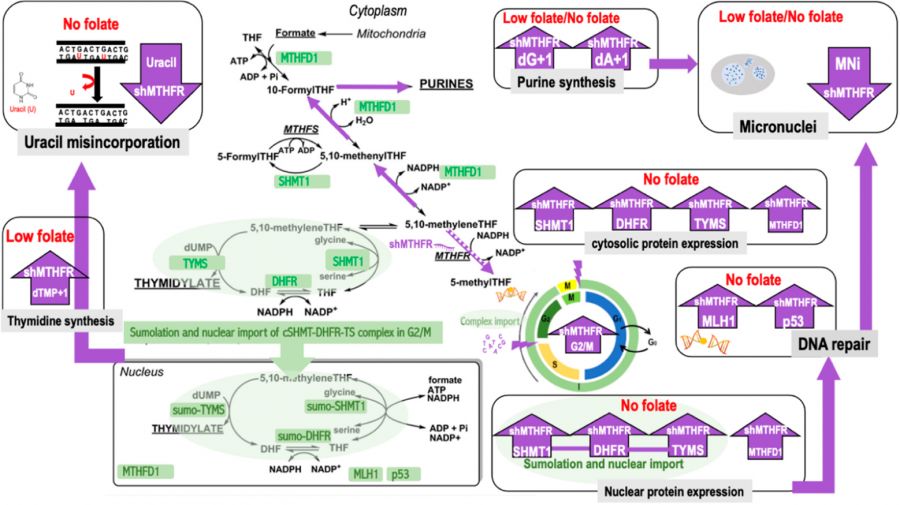循環農業:農業廢棄物再資源化【食品暨應用生物科技學系/蔣恩沛特聘教授】
| 論文篇名 | 英文:MTHFR Knockdown Assists Cell Defense against Folate Depletion Induced Chromosome Segregation and Uracil Misincorporation in DNA 中文:MTHFR 敲落有助於細胞防禦葉酸消耗引起的染色體分離和尿嘧啶在 DNA 中的錯誤摻入 |
| 期刊名稱 | International Journal of Molecular Sciences |
| 發表年份,卷數,起迄頁數 | 2021, 22, 9392 |
| 作者 | Wu, Ming-Tsung; Ye, Wei-Ting; Wang, Yi-Cheng; Chen, Po-Ming; Liu, Jun-You; Tai, Chien-Kuo; Tang, Feng-Yao; Li, Jian-Rong; Liu, Chun-Chi; Chiang, En-Pei Isabel(蔣恩沛)* |
| DOI | 10.3390/ijms22179392 |
| 中文摘要 | 葉酸消耗因增加 DNA 鏈斷裂、尿嘧啶錯誤摻入和缺陷修復而導致染色體不穩定。葉酸介導的單碳代謝已被認為通過影響 DNA 完整性在肝細胞癌 (HCC) 的癌變和進展中起關鍵作用。亞甲基四氫葉酸還原酶 (MTHFR) 是催化 5,10-亞甲基四氫葉酸向 5-甲基四氫葉酸不可逆轉化的酵素,可控制葉酸輔因子分佈並調節細胞內單碳部分的分配。MTHFR 多態性與 HCC 風險之間的關聯是不一致的,在人群研究中仍然存在爭議。我們旨在建立肝臟起源的體外細胞模型,以闡明 MTHFR 功能、葉酸狀態及染色體穩定性之間的相互作用。在本研究中,我們 (1) 檢查了 HCC 患者中 MTHFR 的表達;(2) 使用慢病毒載體遞送的小髮夾 RNA 建立了穩定抑制 MTHFR 的肝臟來源細胞模型,以及 (3) 研究了降低的 MTHFR 和葉酸狀態對細胞週期、甲基基團穩態、核苷酸生物合成和 DNA 的影響穩定性,所有這些都是參與 DNA 完整性和修復的途徑,對人類腫瘤發生至關重要。通過分析 GEPIA2 中可用的 TCGA/GTEx 數據集,我們發現 MTHFR 較高的 HCC 癌症患者的生存率較低。 MTHFR 的 shRNA (shMTHFR) 導致人肝癌細胞 HepG2 中 MTHFR 基因表達、MTHFR 蛋白和酶活性降低。 shMTHFR 傾向於降低細胞內 S-腺苷甲硫胺酸 (SAM) 含量,但葉酸消耗同樣降低野生型 (WT)、負對照 (Neg) 和 shMTHFR 細胞中的 SAM,表明在肝臟來源的細胞中,shMTHFR 不會加劇在葉酸枯竭狀態下的甲基供應。shMTHFR 導致 G2/M 期細胞積累,G2/M 期細胞數量與 MTHFR 基因水平 (r=-0.81, p<0.0001)、MTHFR 蛋白表達 (r=-0.8; p=0.01) 呈負相關,和 MTHFR 酶活性 (r=-0.842; p=0.005)。葉酸消耗導致 WT 和 Neg 中的 G2/M 細胞週期停滯,但在 shMTHFR 細胞中沒有,表明 shMTHFR 不會加劇葉酸消耗誘導的 G2/M 細胞週期停滯。此外,shMTHFR 促進核胸苷合成酶複合物 SHMT1/DHFR/TYMS 的表達和易位,並在葉酸限制下輔助葉酸依賴性之核苷酸生物合成。最後,shMTHFR 促進了葉酸缺乏下核 MLH1/p53 的表達,並進一步減少了葉酸缺乏下的微核形成和 DNA 尿嘧啶錯誤摻入。總之,HepG2 中的 shMTHFR 誘導細胞週期停滯在 G2/M,這可能會促進核苷酸供應並幫助細胞防禦葉酸消耗引起的染色體分離和 DNA 中的尿嘧啶錯誤摻入。本研究為 MTHFR 功能對肝組織染色體穩定性的顯著影響提供了見解。本研究的數據可能揭示 MTHFR 調節肝臟惡性腫瘤風險的潛在調節機制。 |
| 英文摘要 | Folate depletion causes chromosomal instability by increasing DNA strand breakage, uracil misincorporation, and defective repair. Folate mediated one-carbon metabolism has been suggested to play a key role in the carcinogenesis and progression of hepatocellular carcinoma (HCC) through influencing DNA integrity. Methylenetetrahydrofolate reductase (MTHFR) is the enzyme catalyzing the irreversible conversion of 5,10-methylenetetrahydrofolate to 5-methyltetrahydrofolate that can control folate cofactor distributions and modulate the partitioning of intracellular one-carbon moieties. The association between MTHFR polymorphisms and HCC risk is inconsistent and remains controversial in populational studies. We aimed to establish an in vitro cell model of liver origin to elucidate the interactions between MTHFR function, folate status, and chromosome stability. In the present study, we (1) examined MTHFR expression in HCC patients; (2) established cell models of liver origin with stabilized inhibition of MTHFR using small hairpin RNA delivered by a lentiviral vector, and (3) investigated the impacts of reduced MTHFR and folate status on cell cycle, methyl group homeostasis, nucleotide biosynthesis, and DNA stability, all of which are pathways involved in DNA integrity and repair and are critical in human tumorigenesis. By analyzing the TCGA/GTEx datasets available within GEPIA2, we discovered that HCC cancer patients with higher MTHFR had a worse survival rate. The shRNA of MTHFR (shMTHFR) resulted in decreased MTHFR gene expression, MTHFR protein, and enzymatic activity in human hepatoma cell HepG2. shMTHFR tended to decrease intracellular S-adenosylmethionine (SAM) contents but folate depletion similarly decreased SAM in wildtype (WT), negative control (Neg), and shMTHFR cells, indicating that in cells of liver origin, shMTHFR does not exacerbate the methyl group supply in folate depletion. shMTHFR caused cell accumulations in the G2/M, and cell population in the G2/M was inversely correlated with MTHFR gene level (r = −0.81, p < 0.0001), MTHFR protein expression (r = −0.8; p = 0.01), and MTHFR enzyme activity (r = −0.842; p = 0.005). Folate depletion resulted in G2/M cell cycle arrest in WT and Neg but not in shMTHFR cells, indicating that shMTHFR does not exacerbate folate depletion-induced G2/M cell cycle arrest. In addition, shMTHFR promoted the expression and translocation of nuclei thymidine synthetic enzyme complex SHMT1/DHFR/TYMS and assisted folate-dependent de novo nucleotide biosynthesis under folate restriction. Finally, shMTHFR promoted nuclear MLH1/p53 expression under folate deficiency and further reduced micronuclei formation and DNA uracil misincorporation under folate deficiency. In conclusion, shMTHFR in HepG2 induces cell cycle arrest in G2/M that may promote nucleotide supply and assist cell defense against folate depletion-induced chromosome segregation and uracil misincorporation in the DNA. This study provided insight into the significant impact of MTHFR function on chromosome stability of hepatic tissues. Data from the present study may shed light on the potential regulatory mechanism by which MTHFR modulates the risk for hepatic malignancies. |
| 發表成果與本中心研究主題相關性 | 建立質譜代謝路徑追蹤平台之應用 |







